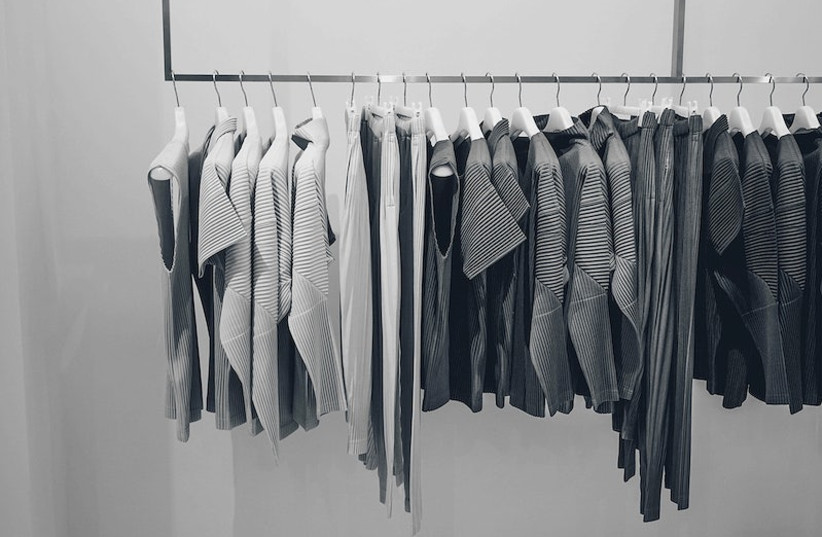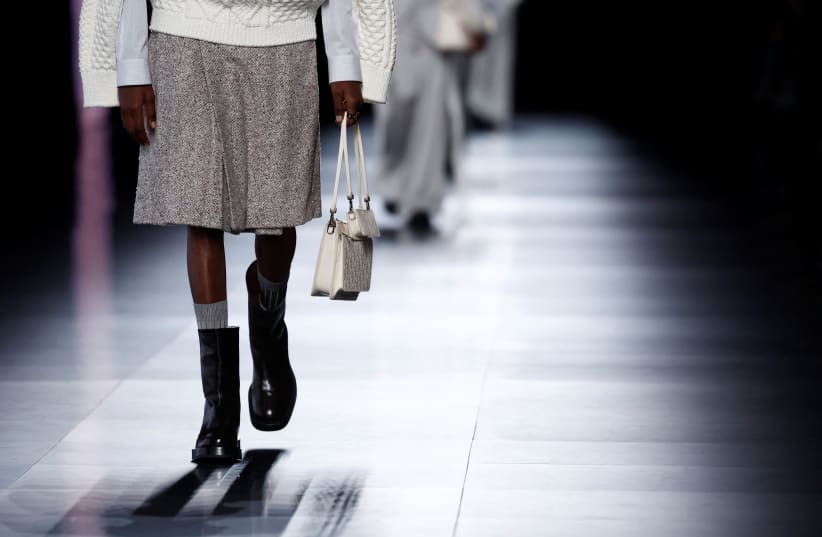Kornit Tel Aviv Fashion Week 2023 began Sunday and the opening shot was fired by the hottest designer in the Jaffa neighborhoods - David Wexler, with a display that will not be forgotten.
In the show that opens the fashion week, which feels a bit like an escape from the stormy reality, Wexler reminded us of the struggle that happens outside the walls of Hangar 11 and called for democracy and equality.
The new recycled fashion collection, "David's Return: Clothes from the Future," was designed with artificial intelligence in collaboration with Kornit Digital.
"I took all my content worlds and processed them through AI programming, the result was my visual starting point for my collection, from the translation to my thoughts, my collaboration with the robot," the designer told Maariv. "It's something that draws a line between the old and the new, it's more technological."
Starting with the reinvention of a trench coat, a police uniform that became a suit and a T-shirt that became pants, the brand's logo and prints were proudly emblazoned on the runway, presenting a new chapter in the story of Wexler's tribe of desert dwellers. This time - a fight between two tribes, which feels very familiar and close to our reality, doesn't it?


Three different printing techniques and different new colors were seen on the runway that refreshed the color palette associated with Wexler. Besides the new and interesting items, there were also the desirable and beloved items of the designer - with several new twists. In addition, as part of the act of protest, the models carried signs calling for democracy, LGBT rights, acceptance of others and equality.
What is Wexler's story?
"My story is cliché, 'a nine-year-old boy who draws clothes [grows up] and becomes a fashion designer,'" Wexler said. "I didn't exactly know what I was doing, I would just draw female characters, do their hair, make-up and clothes. It took me a few years before I got to study drawing, so the teacher informed me: 'You should study fashion design.'"
And so it was, he enrolled in undergraduate studies in textile design at Shankar College and soon found himself also studying in the fashion design department. Shortly after completing his bachelor's degree, he was accepted for a master's degree at Central Saint Martins in London.
The designer's love for design is great, if not huge, but the value of sustainability is much more important for him. He said that most of the raw materials for the production of the collections are created in his studio, "Everything Made in Jaffa".
"They donate the raw materials, clothes, shoes and fabrics that they don't need anymore. They know in the area that I work with everything. Sometimes there is no more room in the studio, the warehouse is full. It's amazing, people want to recycle, I didn't think they would donate such an amount," he said.
"I've been living in Jaffa for 8 years," Wexler said, noting that he did his last fashion shows on the streets of the flee market. "I really like the idea of bringing my fashion to 'real people', those who live here, who are part of my life and environment. It was very meaningful for me to do the shows on the street, both the people on the street and the small businesses saw it and as they are part of our lives - they are also part of it. Part of everyone's culture."
Where do you get inspiration for the collections?
It varies a lot from collection to collection, but there is always a line that connects them all," he said. "I take inspiration from many places, from classic art to comics and DND, to philosophy and abstract ideas. My latest collections are actually part of one story and each collection is like a chapter in a story. They're a guideline of this tribe, the desert dwellers, with the masks and re cycled clothes and we are in some kind of post-apocalyptic fantasy. And the story continues."
'Traitorous leftist'
We will go back in time, a little after the Balfour protests in 2020-2021. Wexler graduated from Central Saint Martins and for his graduation collection he called it "Clothes for Traitors."
"The idea was from a Jewish fantasy, post-apocalyptic, something futuristic and very dreamy, unrealistic," he shared. "In London, I always felt the need to tell our story, mine, as an Israeli man. I wanted to show our sides - the tough and macho side, and the gentle, homoerotic, sensitive and vulnerable side."
"There was text in Hebrew on the clothes, there were jokes that the British didn't understand, I wanted to give them the frustration of 'I don't understand Hebrew,'" he added. "I wanted to give them the understanding that the clothes are not meant for them, but for us."
Why did you choose the name "Clothes for Traitors" for the collection?
The collection, then, was influenced by the protests of the political left. He explained: "The idea of 'we are leftists, we believe in peace' is seen as 'traitors' in this country. I wanted to make something sexy out of it, not to apologize for it, to say 'I am a traitor - this is how traitors dress, this is how traitors look and you would like to be like us."
And history repeats itself - this time too, with protest signs that shouted, among other things like "Save"; "Democracy for all"; "We are all sisters"; "Clothes for traitors"; and "Democracy or rebellion", a demonstration on the runway and clothes designed by him and Kessler delivered a sharp message: "You would die to be like us."
